Chords Guitar - Google Blog Search |
- <b>Guitar Chords</b> And Lyrics free download for Android
- Ultimate <b>Guitar</b> Tabs & <b>Chords</b> | Apps Tribune | App Review
- 9 Blues <b>Guitar Chords</b> to Rock The House! - <b>Guitar</b> Habits
- <b>Guitar</b> Tricks: Eight Things You Need to Know About Arpeggios <b>...</b>
- Using Alternate Bass in <b>Guitar Chords</b> - Open Slash <b>Chords</b>
| <b>Guitar Chords</b> And Lyrics free download for Android Posted: 27 Oct 2014 01:54 AM PDT Summary: Guitar Chords And Lyrics is an online android application that help you to find guitar chords for your favorite songs Updated: Oct 27, 2014 Requirements: Android OS | ||
| Ultimate <b>Guitar</b> Tabs & <b>Chords</b> | Apps Tribune | App Review Posted: 18 Nov 2014 08:39 PM PST  Music has been referred as food for the soul, I don't know much about music, but like everybody else I love a good tune and melody. I have never got any chance to learn to play any musical instrument in my life, but I've always wanted to learn to play guitar. A couple of years ago, I bought a guitar and a friend helped me with some basic lessons, but I could not continue the practice on a regular basis. I can still strum a bit while following a tab & chords lesson, but I could not create any tune on my own. That may have something to do with the non-cooperative brain cells designated to create something new. Playing Guitar (Image Source: Frabz) During my irregular practice sessions, I come across a website which was full of guitar tabs and chords. Ultimate-Guitar was the website with more than 800,000 songs, catalog with free chords, Guitar tabs, Bass tabs, Ukulele chords and guitar pro tabs. Ultimate Guitar Tabs & Chords (Image Source: Google Play) Now we have a dedicated app for it. Ultimate Guitar Tabs & Chords is a pocket version of the website, so that you can get any tune's guitar tabs & chords anywhere. This means that you can practice anywhere and anytime. The app is just like a pocket version of the website with almost all features packed in a smaller version. Ultimate Guitar Tabs & Chords (Image Source: Google Play) The best feature of the app is the availability of all of its content, even if you are offline.. This makes it an extremely useful resource for young learners. They can get their lyrics, tabs, and chords anywhere and start jamming whenever they want. Ultimate Guitar Tabs & Chords (Image Source: Google Play) Another feature of the app is its huge database of songs. The website has more than 800,00 songs with lyrics, tabs and chords. The searching feature in the website is awesome and fast, you don't have to bother much with song title and artists' names, you can just write down a couple of lyrics and your desired song will be right in front of you in a jiffy. Ultimate Guitar Tabs & Chords (Image Source: Google Play) Another interesting feature of the app is that you can learn guitar from scratch and that is too on your own. The interactive lessons are equally good for new learners and people who wants to refresh their skills. However, this feature is only available if you are willing to pay a little more for an already paid app. Ultimate Guitar Tabs & Chords (Image Source: Google Play) The app offers the following features with its paid version:
Ultimate Guitar Tabs & Chords (Image Source: Google Play) Wrap Up The app is a wonderful resource for young musicians, especially with its feature of offline content availability. The app is a cross-platform app and a paid one. You can also add extra features through in-app purchases. I have tried this app and was really impressed with the user experience I got. A must have for young and amateur musicians. Apps Tribune Rating 4/5 Google+ | ||
| 9 Blues <b>Guitar Chords</b> to Rock The House! - <b>Guitar</b> Habits Posted: 23 Oct 2014 01:36 PM PDT Bigstock photo But also the ninth and thirteenth chords are found regularly in blues music to give that extra flavor to a chord progression. They add a little bit of jazz flavor. Choosing the right blues chords can make your blues rhythm playing sound fresh and full of color. Playing these blues chords in different positions will give you a unique sound every time again and makes playing rhythm much more fun and challenging. The blues chords shown below are all in the key of A, however they are moveable chords so they can be played in every key. The red dot indicates the root note. In the diagrams below all red notes are "A" notes. If you would move all the chords up a whole step then the chords are in the key of B. If you want the chords to be in the key of E, then move the entire chord so that the red dot (root note) lands on the "E" note. Tips: If you like more advanced blues progressions check out this post 3 Juicy blues chord progressions to be prepared Expand your blues chord vocabulary and have fun! Part I Part II 1 = index finger, 2 = middle finger, 3 = ring finger 4 = pinky
Do you know some nice blues chords please share in the comments. Join the Guitarhabits facebook page to keep up with the latest posts, guitar lesson videos, tips, tricks and other news about Guitarhabits. | ||
| <b>Guitar</b> Tricks: Eight Things You Need to Know About Arpeggios <b>...</b> Posted: 14 Nov 2014 07:19 AM PST  Photo: commons.wikimedia.org As you advance in your guitar studies, you'll surely come across the term "arpeggio." Arpeggios are a great way to add color and complexity to your playing. You can make riffs out of them, use them in solos or even create melody lines with their fluid sound. Nearly all of the greats use arpeggios. Yet, if you're like a lot of guitarists, you might be shying away from them because you fear being overwhelmed by the "Twin Ts": theory and technique. If you have a basic understanding of how chords work, though, it's high time to get your feet wet. Here are eight things you need to know to help demystify the arpeggio. 01. What an arpeggio is exactly The word arpeggio (ar-peh-jee-oh) comes from the Italian word arpeggiare, which means "to play a harp." (If you can visualize harpists, they often articulate notes by plucking the strings one at a time.) Arpeggios, often called broken chords, are simply notes from a chord played individually instead of strummed together. 02. What arpeggios can do for you. Arpeggios create a fast, flowing sound. Besides using them for speed in playing, arpeggios add a kick to improvisation skills. Because an arpeggio contains all the notes of its chord, you can use them in your solos and link them to what's going on in the chord structure beneath you to create cool sounding licks. Arpeggios always sound good over their matching chord in a progression, therefore, they generally form the melodic home bases and safe notes for improvising guitarists. This guitar chord chart will help visualize the notes of each arpeggio on the guitar neck. 03. Scales vs. arpeggios. Let's clear up any confusion you might have between scales and arpeggios. Scales are a series of notes played one by one that fit sonically within a particular key signature (e.g., G major scale would be G, A, B, C, D, E, F#). Arpeggios, on the other hand, are a series of notes played one by one that consists of the notes within a particular chord (e.g., G major arpeggio would be G, B, D). Like a scale, an arpeggio is linear: it's a set of notes you play one at a time. Unlike scales that contain some extra notes not always played in chords, arpeggios use only the notes found in a single chord. Both scales and arpeggios can be played in ascending, descending or random order. 04. Arpeggio shapes. As with scales, there are a variety of shapes to learn when playing arpeggios. There are generally five CAGED shapes for each arpeggio, except the diminished 7th, for which there is just one. Learn arpeggios in different positions on the neck so you become familiar with the shape of the arpeggio rather than concentrating on which frets to put your fingers in. Learn the shapes one at a time. Although you need to get all five of the shapes down—eventually—it's far better to be able to play one perfectly than five poorly. Practice moving from one arpeggio shape to another, back and forth and back and forth. 05. Which arpeggios to learn first. The best guitar arpeggios to learn first are the major triad (1, 3, 5) and the minor triad (1, b3, 5). The major and minor triads are the most common and most used guitar arpeggios in all of music. While a triad contains only three notes, an arpeggio can be extended with chords like a major seventh, a 9th, 11th, 13th, etc., giving you endless possibilities. 06. Different picking styles. There are several ways you can play arpeggios—alternate picking, legato, hammer-ons and pull-offs, sweep picking and tapping are among them. (For the more experienced player, there also are lead techniques you should be confident with for playing arpeggios at higher speeds, such as string skipping and finger rolling.) Experiment with each way of playing these arpeggios to see which one works best for you and your particular style. A note here about fingerpicking: While fingerpicked chords are technically arpeggios since the chords are broken up, the individual notes aren't typically muted after they're played and thus ring together. The listener can literally hear the entire chord from the vibrations of each individual note. Arpeggios typically only have one note playing at any given time and are a slightly different idea from broken chords. 07. Grab the arpeggio by the "root." When you're brand new to arpeggios, you always want to start and end on a root note (the note upon which a chord is built. Literally, the root of the chord.) This will help train your ears to hear the sound of the scale. Start on the lowest pitched root note, play up as far as you can, then go back down as low as you can, and then back up to the root note. 08. Form and speed. To play arpeggios, you should mute each note immediately after picking it by lifting the fretting finger. This will keep the notes from "bleeding" into one another and sounding like a strummed chord. Every note needs to sound individually. Start off slowly. Perfect your form before you add speed to the mix. You don't want to develop bad habits that you will have to correct later. For more on playing arpeggios, give some of these "how to play arpeggios" guitar lessons a try, as well as Ben Lindholm's Kathy Dickson writes for the online guitar lesson site Guitar Tricks. | ||
| Using Alternate Bass in <b>Guitar Chords</b> - Open Slash <b>Chords</b> Posted: 20 Nov 2014 06:10 PM PST Home > Chords > Alternate Bass Chords are mostly played with the root in the bass, the lowest sounding note in the chord. For example, C major will typically be played with C in the bass. A minor with A in the bass. But what if we were to change the voicing of the chord so a note other than the root was in the bass? Simply changing the bass note of a chord can completely change its sound and even its implied function within a chord progression. In this lesson, we'll explore how to use alternate bass, also known as slash chords, to create progressions using those simple open position chords we learn as beginners. Start by watching the presentation below... Open Position Slash ChordsAs shown in the video, there are different bass notes you can swap for the chord root to change its sound. They're called slash chords because they are written using a... / slash!For example, Cmaj/G tells us to play C major with G in the bass. Am/G tells us to play A minor with G in the bass. Simple! In the diagrams below, the suggested fingering is marked (usual 1 = index to 4 = pinky) but lookout for those X's (do not play that string). With open slash chords we often have to block out more strings. C Major Slash Chords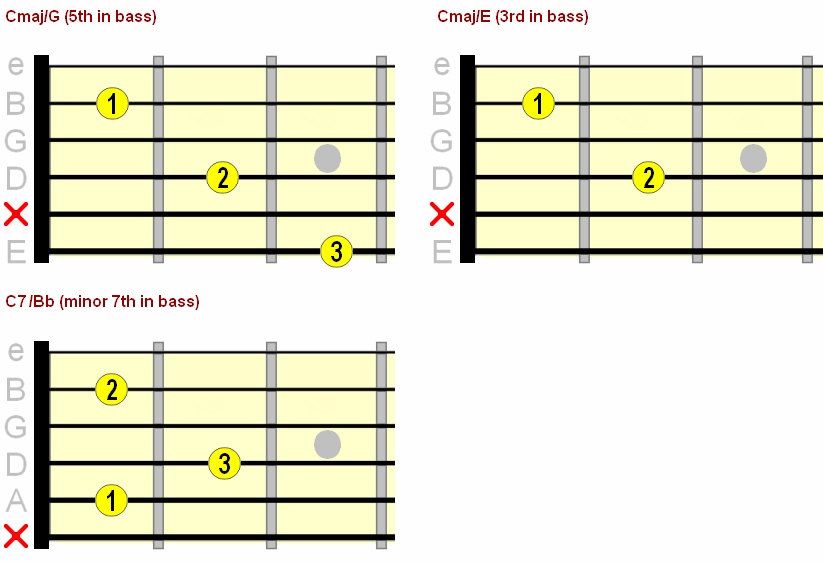 A Major Slash Chords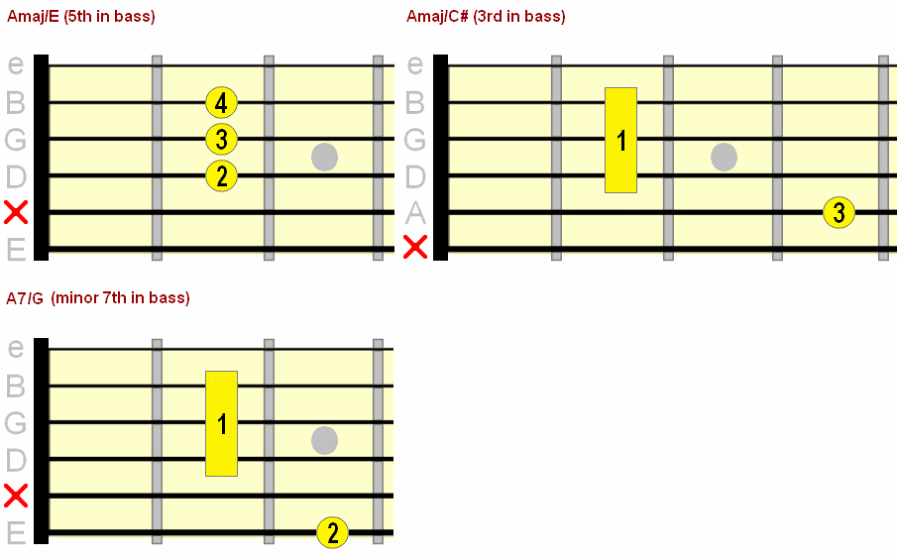 G Major Slash Chords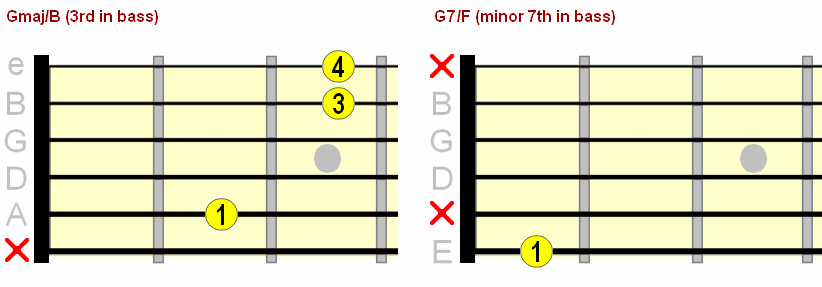 E Major Slash Chords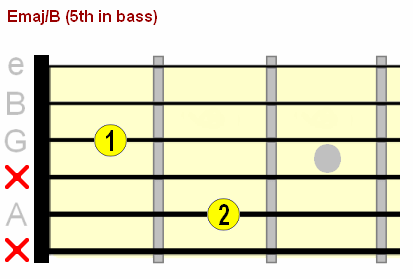 D Major Slash Chords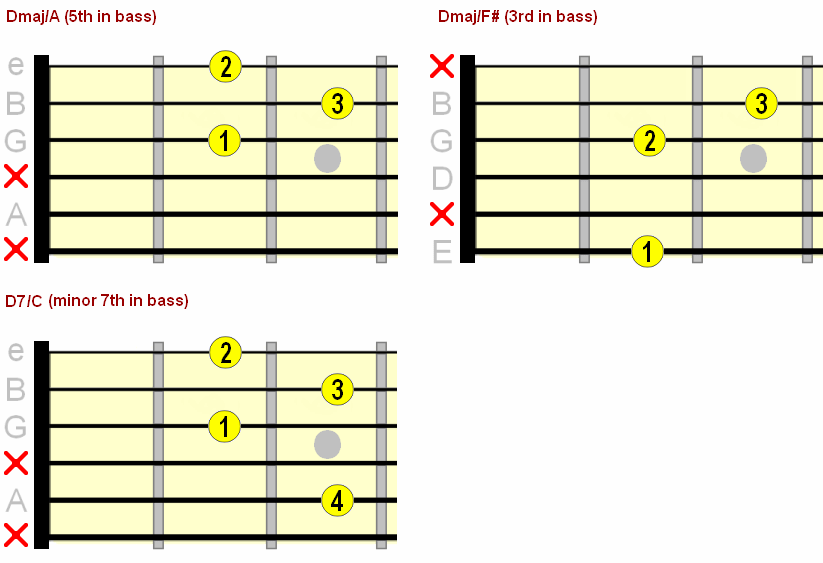 A Minor Slash Chords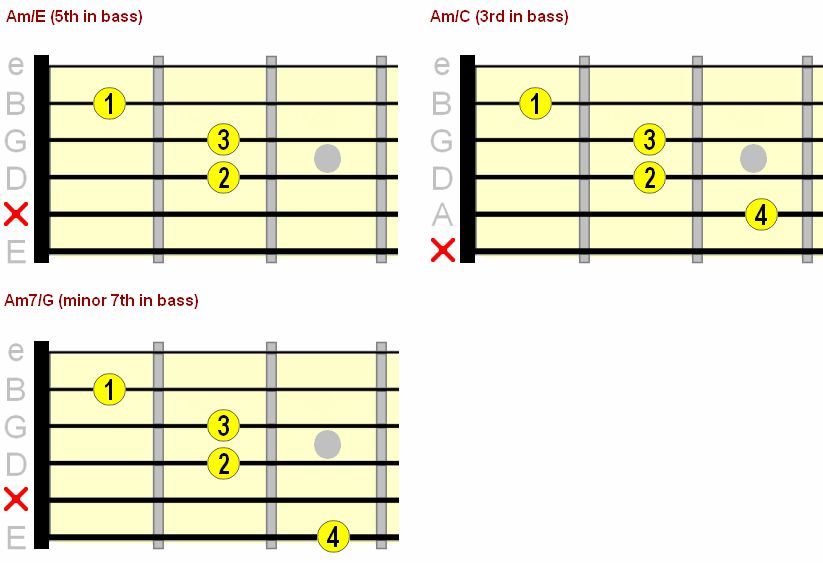 D Minor Slash Chords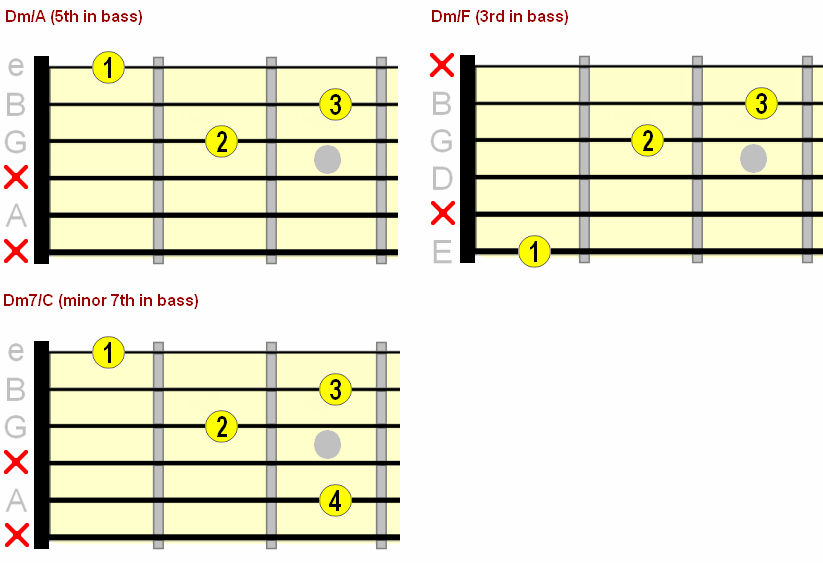 How Alternate Bass Changes Chord FunctionUsing alternate bass clearly changes the individual sound of a chord, but it can also change its anticipated function within a chord progression.In the video I gave you one example - using the 5th of the chord in the bass - of how alternate bass can create a "pull" to a proceeding chord... The 5th Bass - Dominant RelationshipThis is where we use an alternate bass on the 5th of the chord and that bass becomes the root of the proceeding dominant (V) chord. Difficult to explain in words, so take a look at (and play along to) these examples. In each pairing, the first chord is the tonic (I) with a 5th alternate bass, the second chord is the dominant.Key: red = root bass blue = alternate bass
The 5th Bass - Subdominant RelationshipThis time we move from the tonic to the IV chord, but keep the tonic chord's root as the bass of that IV chord. Take a look...
Of course, you're not limited to these functions, so please don't feel these are "rules" you must follow. There are no rules! The examples above are just a way of demonstrating how using alternate bass can change the role of chords in a progression. Start by experimenting with different chord pairings. Use the normal root bass in one chord and an alternate bass in the other. This is a great way of discovering movements that work. Progression Ideas Using Alternate Bass ChordsThe emphasis of my lessons is always on independent exploration and experimentation. But here are a couple of progressions to get you started. Note that, in these examples, I've perhaps used alternate bass a little more than I would when writing a progression, but it's just to demonstrate what can be acheived.The more you play around with different chord/bass combinations, the more ideas you'll generate and the more intuitively you'll begin to use alternate bass. It's as simple as that. You can of course either strum or pick these chords, or a combination. Key: red = root bass blue = alternate bass
Share your thoughts... Have any questions, thoughts or ideas about this lesson? Let us know using the comments form below. |
| You are subscribed to email updates from Chords Guitar - Google Blog Search To stop receiving these emails, you may unsubscribe now. | Email delivery powered by Google |
| Google Inc., 1600 Amphitheatre Parkway, Mountain View, CA 94043, United States | |
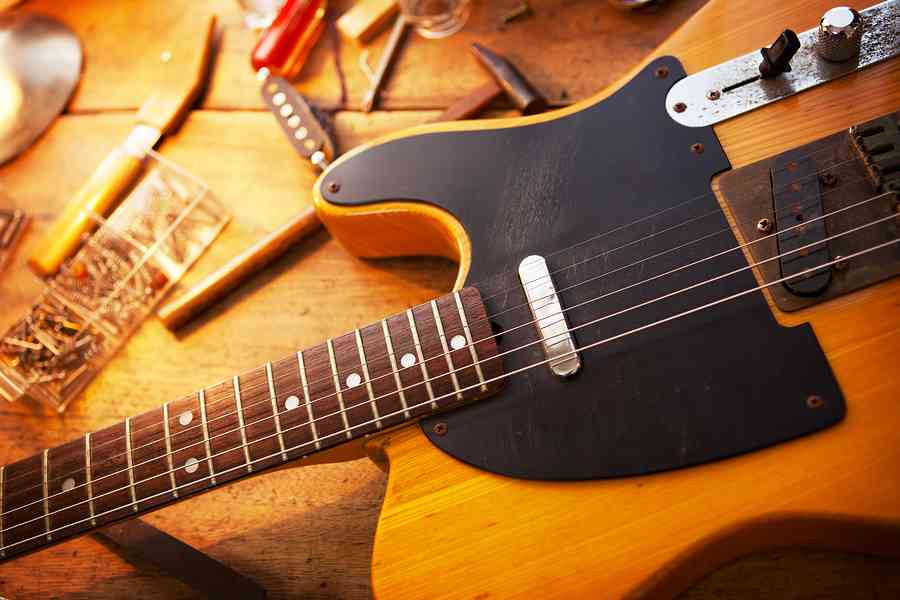 The dominant 7th chord is the most common used chord in blues.
The dominant 7th chord is the most common used chord in blues.


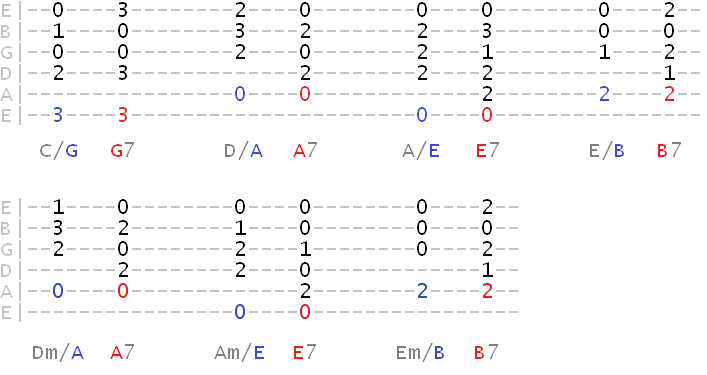

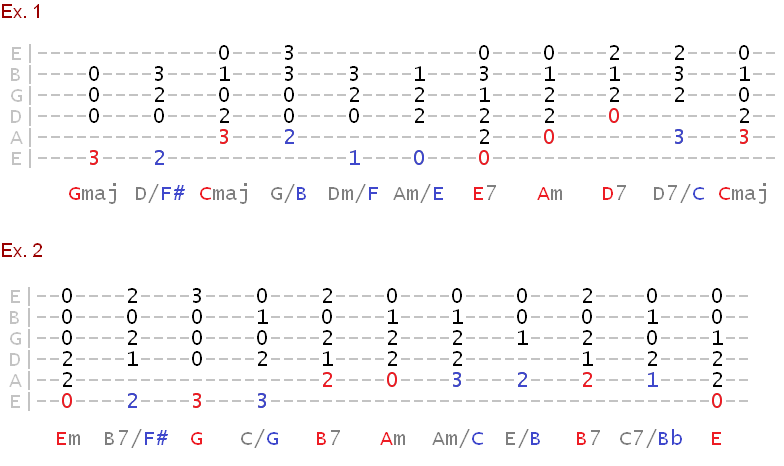


1 comments:
27 November 2022 at 21:26
Must say very Nice & Informative blog. Really, you have some great tips here. If you are looking for guitar coaching to learn guitar then visit Artium Academy today
Post a Comment